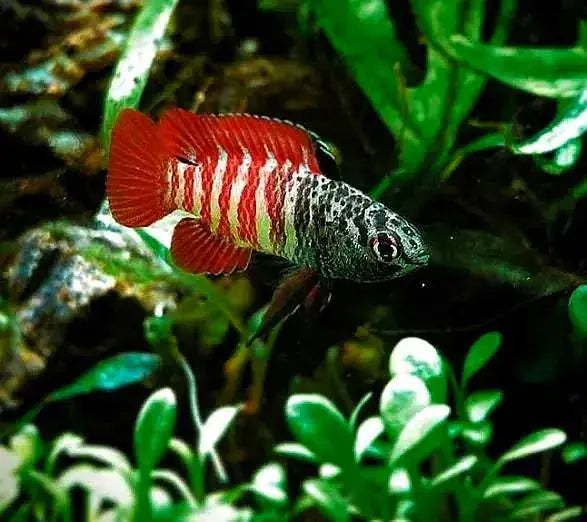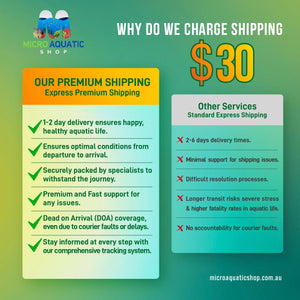Black Tiger Badis (Dario sp. “Myanmar”)
Guarantee Safe Checkout
Black Tiger Badis (Dario sp. 'Myanmar') - Rare Freshwater Fish Guide
Hey there, fellow Aussie fish lovers! Let's explore the amazing world of the Black Tiger Badis (Dario sp. "Myanmar"). This rare freshwater fish has won the hearts of many aquarium fans around the globe. It comes from the peaceful waters of Myanmar, making it a true treasure.  In this guide, we'll dive into the Black Tiger Badis's unique traits and how to care for them. You'll learn how to be the best caretaker for these incredible fish. Join us as we discover the secrets of the Black Tiger Badis and how to add this rare gem to your aquarium.
In this guide, we'll dive into the Black Tiger Badis's unique traits and how to care for them. You'll learn how to be the best caretaker for these incredible fish. Join us as we discover the secrets of the Black Tiger Badis and how to add this rare gem to your aquarium.
Key Takeaways
- The Black Tiger Badis is a rare and sought-after freshwater fish species from Myanmar.
- These captivating fish are known for their distinctive colouration and intriguing behaviours.
- Caring for the Black Tiger Badis requires a keen understanding of their natural habitat and specific water parameters.
- Proper tank setup, feeding, and compatibility considerations are essential for the successful long-term maintenance of this species.
- Breeding the Black Tiger Badis can be a rewarding challenge for experienced aquarists.
Understanding the Black Tiger Badis (Dario sp. "Myanmar")
The Black Tiger Badis is a stunning freshwater fish from Myanmar. It's a favourite among aquarium lovers worldwide. This small fish is a true treasure in the world of dwarf fish.
Natural Habitat and Distribution
The Black Tiger Badis lives in Myanmar's slow-moving streams. It's found in the Irrawaddy River basin and other waterways. Its home is filled with plants, logs, and a mix of sand, gravel, and leaves.
Physical Characteristics
The Black Tiger Badis is small, growing to 2 to 3 centimetres. It has striking black and golden-yellow colours. These dwarf badis have big eyes and a small mouth, perfect for their home.
Behaviour Patterns
- The Dario genus, including the Black Tiger Badis, are known for their peaceful and playful demeanour.
- These Burmese badis are often seen swimming in small groups, exploring their surroundings with curiosity.
- When threatened, the Myanmar badis will quickly seek refuge among the plants and decorations in their aquarium.
- During courtship and breeding, the males will display vibrant colours and engage in intricate underwater dances to impress the females.
Knowing the Black Tiger Badis's unique traits and habits is key. It helps ensure these fish get the best care and environment in your aquarium.
Setting Up the Perfect Tank Environment
Creating the perfect home for our nano fish, the Black Tiger Badis, is key. We must focus on the aquarium setup and tank requirements. This species thrives in a well-crafted environment that mirrors their natural habitat. The tank size is very important. We suggest a 10-gallon (38-litre) tank, but a 15-20 gallon (57-76 litre) is even better. This size provides enough space for swimming and setting up the right water conditions.
Substrate and Décor
Choosing the right substrate is crucial. Fine gravel or sand is best because it looks natural. Add live plants like Java Moss, Anubias, and Cryptocoryne. They make the tank look good and give our shy fish places to hide. Adding driftwood, rocks, and safe decorations is also important. It makes the tank look great and meets our fish's needs.
Water Parameters
- Temperature: 72-82°F (22-28°C)
- pH: 6.0-7.5
- Hardness: Soft to medium (2-12 dKH)
Keeping the water parameters right is vital for our fish's health. Regular water tests and changes are needed to keep the water quality high.
| Parameter | Ideal Range |
| Temperature | 72-82°F (22-28°C) |
| pH | 6.0-7.5 |
| Hardness | Soft to medium (2-12 dKH) |
By setting up the tank carefully, we can give our Black Tiger Badis a great place to live. It meets their needs and lets them show off their beauty.
Feeding Requirements and Diet Preferences
The Black Tiger Badis is a fascinating fish, but their diet needs careful thought. They love live foods, which are key to their fish diet.
Live Food Options
Black Tiger Badis enjoy a variety of live foods. These include:
- Daphnia
- Brine shrimp
- Mosquito larvae
- Micro worms
- Micro predators
Offering a mix of live foods meets their natural hunger. It also gives them all the nutrients they need.
Commercial Feed Alternatives
While live foods are best, you can also use high-quality fish flakes or sinking pellets. These should be rich in protein to match their fish diet. Use these sparingly, especially when live foods are hard to find.
Feeding Schedule
Black Tiger Badis eat often because they have a fast metabolism. Feed them 2-3 times a day. Each meal should be just enough for them to eat in a few minutes. This keeps their energy up and their fish diet balanced. By understanding and meeting the Black Tiger Badis's dietary needs, we can help them thrive. They will continue to amaze us with their charm and unique behaviour.
Tank Mates and Compatibility
When choosing tank mates for the Black Tiger Badis (Dario sp. "Myanmar"), remember their peaceful nature and small size. It's crucial to pick compatible species that won't harm these delicate fish. This ensures a harmonious community tank.  Consider the size of your tank mates. Black Tiger Badis grow up to 3-4 cm long. So, choose peaceful fish that are similar or slightly bigger. Good choices include:
Consider the size of your tank mates. Black Tiger Badis grow up to 3-4 cm long. So, choose peaceful fish that are similar or slightly bigger. Good choices include:
- Dwarf Corydoras (Corydoras pygmaeus)
- Pygmy Rasboras (Boraras brigittae)
- Ember Tetras (Hyphessobrycon amandae)
- Chili Rasboras (Boraras merah)
Avoid aggressive or fin-nipping fish. They might stress the Black Tiger Badis. Also, stay away from larger fish that could bully or outcompete them. By picking the right tank mates and creating a peaceful community tank, you'll give the Black Tiger Badis a great place to thrive. They'll show off their unique behaviours in this environment.
Breeding and Reproduction
Breeding the Black Tiger Badis is a thrilling adventure for aquarium lovers. These stunning fish, known for their bubble nests and labyrinth-like swimming, need special care to breed.
Breeding Conditions
To breed them successfully, we must recreate their natural home. This means setting up a breeding tank with soft, acidic water and lots of plants. A gentle flow and hiding spots are also key to their comfort during breeding.
Fry Care and Development
After the female lays eggs, the male will take care of the bubble nest. This keeps the eggs oxygenated. Once hatched, the fry need tiny foods like baby brine shrimp to grow fast.
Success Rate Factors
- Water quality and stability: Keeping the water perfect is vital for the fish and their young.
- Appropriate feeding and nutrition: A diet full of live foods boosts breeding chances and nourishes the fry.
- Stress-free environment: Reducing stress with plenty of hiding spots can improve breeding success.
With the right setup and patience, breeding these bubble nest builders and labyrinth fish can be incredibly rewarding. By following these tips, aspiring fish breeders can successfully raise the enchanting Black Tiger Badis.
Health Management and Common Issues
Keeping our Black Tiger Badis (Dario sp. 'Myanmar') healthy is key for their long life. They can get sick if their tank isn't clean. But, with the right care, we can keep them well. Ich is a common sickness in Black Tiger Badis. It shows as white spots and makes them scratch a lot. If not treated, it can be deadly. Luckily, salt and temperature changes can cure it.
- Watch your Badis for signs of sickness, like being tired or not eating.
- Quarantine new fish to stop diseases from spreading.
- Keep the water clean with regular changes and tank cleaning.
By watching closely and caring for them, our Black Tiger Badis can stay healthy. With the right care, they can be a joy for years in our aquariums.
Maintenance and Water Parameters
Keeping the water quality right is key for our Black Tiger Badis (Dario sp. 'Myanmar'). This rare fish needs a specific water balance to do well in our tanks. Let's look at what water chemistry they need and how to keep their home clean.
Water Chemistry Requirements
The Black Tiger Badis comes from Myanmar's soft, acidic waters. We must match these conditions in our tanks. Aim for a pH of 6.0 to 7.0 and a temperature of 22-26°C. Hardness should be low, between 2-8 dGH. Testing water often is crucial. We need to check for ammonia, nitrites, and nitrates. This keeps the water stable and healthy for our Badis.
Regular Maintenance Schedule
To keep our Black Tiger Badis happy, we must stick to a regular care plan. This includes:
- Changing 25-30% of the water weekly. This adds fresh water and removes waste and toxins.
- Cleaning the substrate and decorations well. This removes debris and algae.
- Checking and adjusting water parameters regularly. This ensures the water is right for our Badis.
- Keeping an eye on the tank's filter. It must work well to keep the water clear and full of oxygen.
By sticking to this care plan and watching the water quality, we can give our Black Tiger Badis the best home. They will thrive and show off their beauty in our tanks.
Conclusion
The Black Tiger Badis (Dario sp. "Myanmar") is a captivating and rare freshwater fish. It's a great choice for aquarium hobbyists. Its striking looks, interesting behaviours, and special care needs make it rewarding to keep.  If you're thinking of getting this exotic fish, check out Micro Aquatic Shop. They offer a wide range of fish and expert advice. They're a trusted source for aquarium lovers in Australia, ensuring you get the best for your Black Tiger Badis. Whether you're experienced or new to exotic fish, the Black Tiger Badis will amaze you. With proper care and attention, you'll see its true beauty. It promises hours of enjoyment and wonder.
If you're thinking of getting this exotic fish, check out Micro Aquatic Shop. They offer a wide range of fish and expert advice. They're a trusted source for aquarium lovers in Australia, ensuring you get the best for your Black Tiger Badis. Whether you're experienced or new to exotic fish, the Black Tiger Badis will amaze you. With proper care and attention, you'll see its true beauty. It promises hours of enjoyment and wonder.
FAQ
What is a Black Tiger Badis (Dario sp. "Myanmar")?
The Black Tiger Badis, also known as the Burmese Badis or Myanmar Badis, is a rare freshwater fish. It belongs to the Dario genus. This dwarf badis species is from the Shan State region of Myanmar and is loved by aquarium fans worldwide.
Where do Black Tiger Badis originate from?
Black Tiger Badis come from the Shan State region of Myanmar. They live in small, slow-moving streams and rivers. Their rarity in aquariums is due to their limited geographic area.
What are the physical characteristics of the Black Tiger Badis?
Black Tiger Badis are small, growing up to 3 centimetres long. They have a dark body with iridescent blue-green stripes, giving them a tiger-like look. Their fins are colourful, with red, orange, and yellow splashes.
How do Black Tiger Badis behave in the aquarium?
Black Tiger Badis are peaceful and interesting to watch. They can breathe air from the surface, thanks to a special organ. They build bubble nests and are active, interacting well with other fish in a suitable community.
What are the ideal tank requirements for keeping Black Tiger Badis?
Black Tiger Badis need well-planted, dimly-lit tanks with soft, acidic water. A 10-gallon tank is a good size, with lots of plants and hiding spots. Keep the water's pH between 6.0-7.5 and temperature between 22-26°C.
What do Black Tiger Badis eat?
In the wild, they eat small invertebrates and zooplankton. In tanks, they like live or frozen foods like brine shrimp and daphnia. Feed them often but in small amounts for a varied diet.
What are the best tank mates for Black Tiger Badis?
Black Tiger Badis are peaceful and can live with other small fish. Good tank mates include tetras, rasboras, and dwarf corydoras. Avoid aggressive or large fish that might bother them.
How do we breed Black Tiger Badis?
Breeding Black Tiger Badis is challenging but rewarding. They need specific water and a breeding tank. The male builds a bubble nest, and the female lays eggs there. Fry need careful care and a diet of infusoria and small foods.
What are some common health issues that affect Black Tiger Badis?
Black Tiger Badis can get fin rot, ich, and bacterial infections. Keeping the water clean and avoiding stress is key. Watch the fish closely and quarantine new ones to prevent disease.
How do we maintain the water parameters for Black Tiger Badis?
Black Tiger Badis need soft, slightly acidic, and well-oxygenated water. Change 20-30% of the water regularly. Also, check pH, temperature, and oxygen levels often to keep them healthy.
| Size |
1 juvie random sex |
|---|









